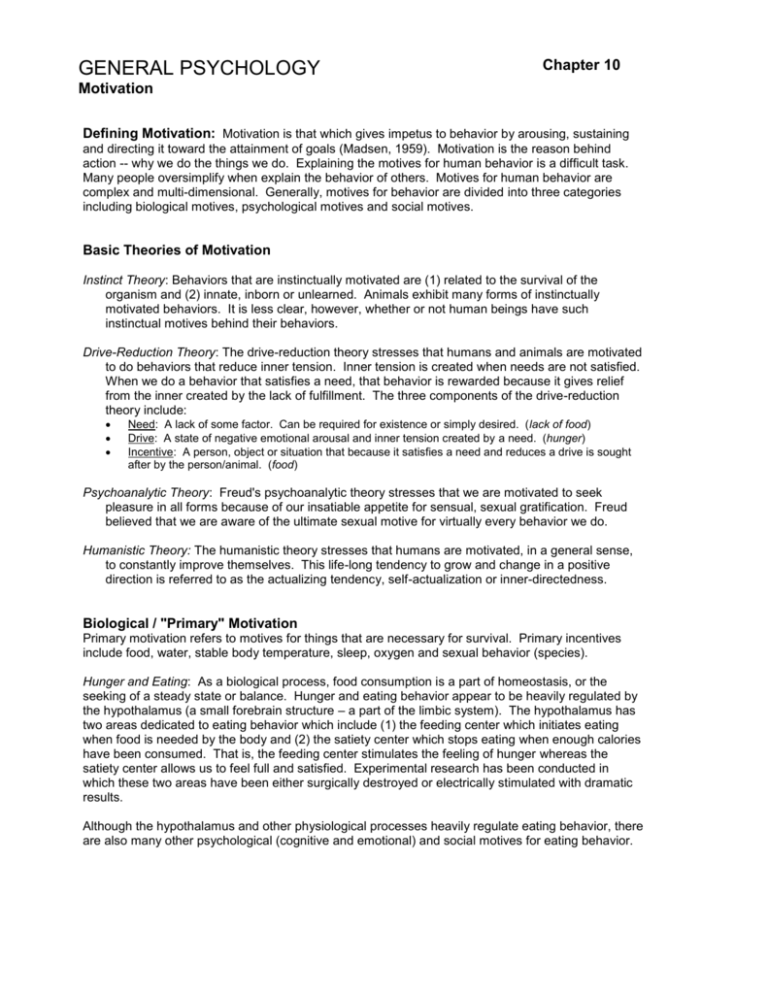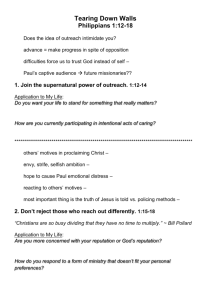Chapter 10 Class Notes / Motivation
advertisement

GENERAL PSYCHOLOGY Chapter 10 Motivation Defining Motivation: Motivation is that which gives impetus to behavior by arousing, sustaining and directing it toward the attainment of goals (Madsen, 1959). Motivation is the reason behind action -- why we do the things we do. Explaining the motives for human behavior is a difficult task. Many people oversimplify when explain the behavior of others. Motives for human behavior are complex and multi-dimensional. Generally, motives for behavior are divided into three categories including biological motives, psychological motives and social motives. Basic Theories of Motivation Instinct Theory: Behaviors that are instinctually motivated are (1) related to the survival of the organism and (2) innate, inborn or unlearned. Animals exhibit many forms of instinctually motivated behaviors. It is less clear, however, whether or not human beings have such instinctual motives behind their behaviors. Drive-Reduction Theory: The drive-reduction theory stresses that humans and animals are motivated to do behaviors that reduce inner tension. Inner tension is created when needs are not satisfied. When we do a behavior that satisfies a need, that behavior is rewarded because it gives relief from the inner created by the lack of fulfillment. The three components of the drive-reduction theory include: Need: A lack of some factor. Can be required for existence or simply desired. (lack of food) Drive: A state of negative emotional arousal and inner tension created by a need. (hunger) Incentive: A person, object or situation that because it satisfies a need and reduces a drive is sought after by the person/animal. (food) Psychoanalytic Theory: Freud's psychoanalytic theory stresses that we are motivated to seek pleasure in all forms because of our insatiable appetite for sensual, sexual gratification. Freud believed that we are aware of the ultimate sexual motive for virtually every behavior we do. Humanistic Theory: The humanistic theory stresses that humans are motivated, in a general sense, to constantly improve themselves. This life-long tendency to grow and change in a positive direction is referred to as the actualizing tendency, self-actualization or inner-directedness. Biological / "Primary" Motivation Primary motivation refers to motives for things that are necessary for survival. Primary incentives include food, water, stable body temperature, sleep, oxygen and sexual behavior (species). Hunger and Eating: As a biological process, food consumption is a part of homeostasis, or the seeking of a steady state or balance. Hunger and eating behavior appear to be heavily regulated by the hypothalamus (a small forebrain structure – a part of the limbic system). The hypothalamus has two areas dedicated to eating behavior which include (1) the feeding center which initiates eating when food is needed by the body and (2) the satiety center which stops eating when enough calories have been consumed. That is, the feeding center stimulates the feeling of hunger whereas the satiety center allows us to feel full and satisfied. Experimental research has been conducted in which these two areas have been either surgically destroyed or electrically stimulated with dramatic results. Although the hypothalamus and other physiological processes heavily regulate eating behavior, there are also many other psychological (cognitive and emotional) and social motives for eating behavior. Psychological Motivation Psychological motivation refers to motives for things not necessary for the survival of the person, but rather for things that are pleasurable, reduce tension or produce excitement. Motivation for Novel Stimulation: Humans are motivated to seek situations that are new, different and unique. In this instance, we are trying to escape the boredom of objects, people, situations and surroundings that are common and routine. Some higher animals such as monkeys will also work for novel stimulation. Stimulus Motives: Stimulus motives are motives for things that give us excitement. They are closely related to motives for novel stimulation but instead of reducing tension, stimulus motives actually increase tension. When we seek stimulus motives, we are seeking experiences that give us a powerful rush of adrenaline. Examples include seeing slasher movies, riding roller coasters and skydiving. Social Motivation Social motives, like psychological motives, are for things not necessary for survival. Social motives involve situations that give us psychological pleasure through interacting with others and our worlds. The three fundamental social motives that have been research for many years include: Affiliation Motivation: Human beings are social creatures and show a strong motive to associate with, relate to, and spend time with other people. While everyone has affiliation motivation, some people have a higher/lower need for affiliation (N Aff) than others. In either case, the extremes can be maladaptive. Affiliation motivation can be temporarily changed due to changes in a person's environment. Achievement Motivation: Humans have a need to set goals and achieve them. When we don't, we feel stagnated and incompetent. Therefore, we have a natural need to succeed in competitive situations, whether competing with others or ourselves. While we all are motivated toward success, some people have a higher/lower need for achievement (N Ach). Persons with higher than average N Ach have been studied by David McClelland. As above, in the truly extreme cases, too much or too little N Ach can be maladaptive. Power Motivation: Humans have a need to have control over their worlds and the people around them. When our power needs are not met, we feel out of control and frustrated. Power motivation is not an inherently bad thing as some might imagine. We all need to be able to have some control over our worlds. Again, extremes in N Power are maladaptive. Location of Motivational Source Extrinsic Motivation: Refers to being motivated to receive external rewards. Intrinsic Motivation: Refers to being motivated by the simple nature of an activity. Intrinsic motivation occurs when simply doing the behavior is rewarding enough. Rewards are internal. There is a relationship between extrinsic and intrinsic motivations. Contrary to logic, adding extrinsic motives to a situation in which a person is already intrinsically motivated generally results in a decrease in intrinsic motivation. Example: study involving elementary school children being paid to do finger painting. Abraham Maslow's Hierarchy of Needs Theory Humanistic theorist Abraham Maslow believed we work toward fulfilling our needs in an orderly fashion. In his theory, the term "hierarchy" means that a person must generally achieve satisfaction at a lower level in order to be able to move to a higher level. If a person is functioning at a higher level and then loses the ability to meet needs at a lower level, the person will be required to move down to the lower level and spend time meeting the unmet needs there before moving back to the higher level. For instance, if a person is currently working on fulfilling her esteem needs (4th level) and is assaulted and robbed, the new challenge to her sense of security will mandate that she move down to the second level and once again establish a sense of security. Biological Needs (1st Level): The most basic of all needs. Included are deeds for food, water, temperature regulation, pain avoidance and sexual functioning. Safety Needs (2nd Level): Involves the psychological need for a sense of security and stability in life and the feeling that one is not in imminent danger of being harmed. Love & Belongingness Needs (3rd Level): Involves the psychological need to feel a sense of connectedness with others and to feel that there is a group of people to whom one belongs. This need is met in most persons by their association with their nuclear family. Esteem Needs (4th Level): Involves the psychological need to be liked and admired by others, and more importantly, to like and admire oneself. This sense of value in oneself does not involve an unhealthy narcissistic inflated sense of self, but rather a genuine healthy sense of esteem (both self-esteem and esteem from others). Self-Actualizing Needs (5th Level): Involves the psychological need to develop to the highest level and actualize (or put into action) untapped abilities and talents. Involves the strong desire to develop to the ultimate level of human functioning both intellectually and emotionally. According to Maslow, very few people ever reach this level. He estimated only about 1% of our population will ever function at this highest level of being. He also believed that while younger adults may show signs of good potential to eventually become a self-actualizing person, most persons who reach this level are likely in their 50s and beyond. He thought most younger adults were still too focused on developing a sense of belonging or esteem.







